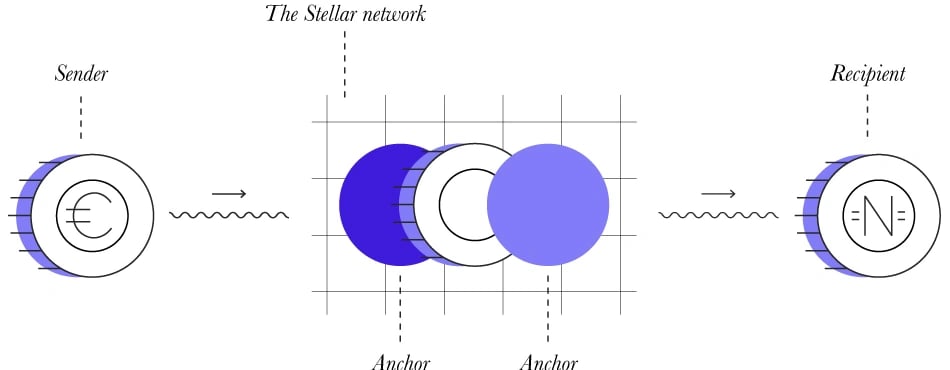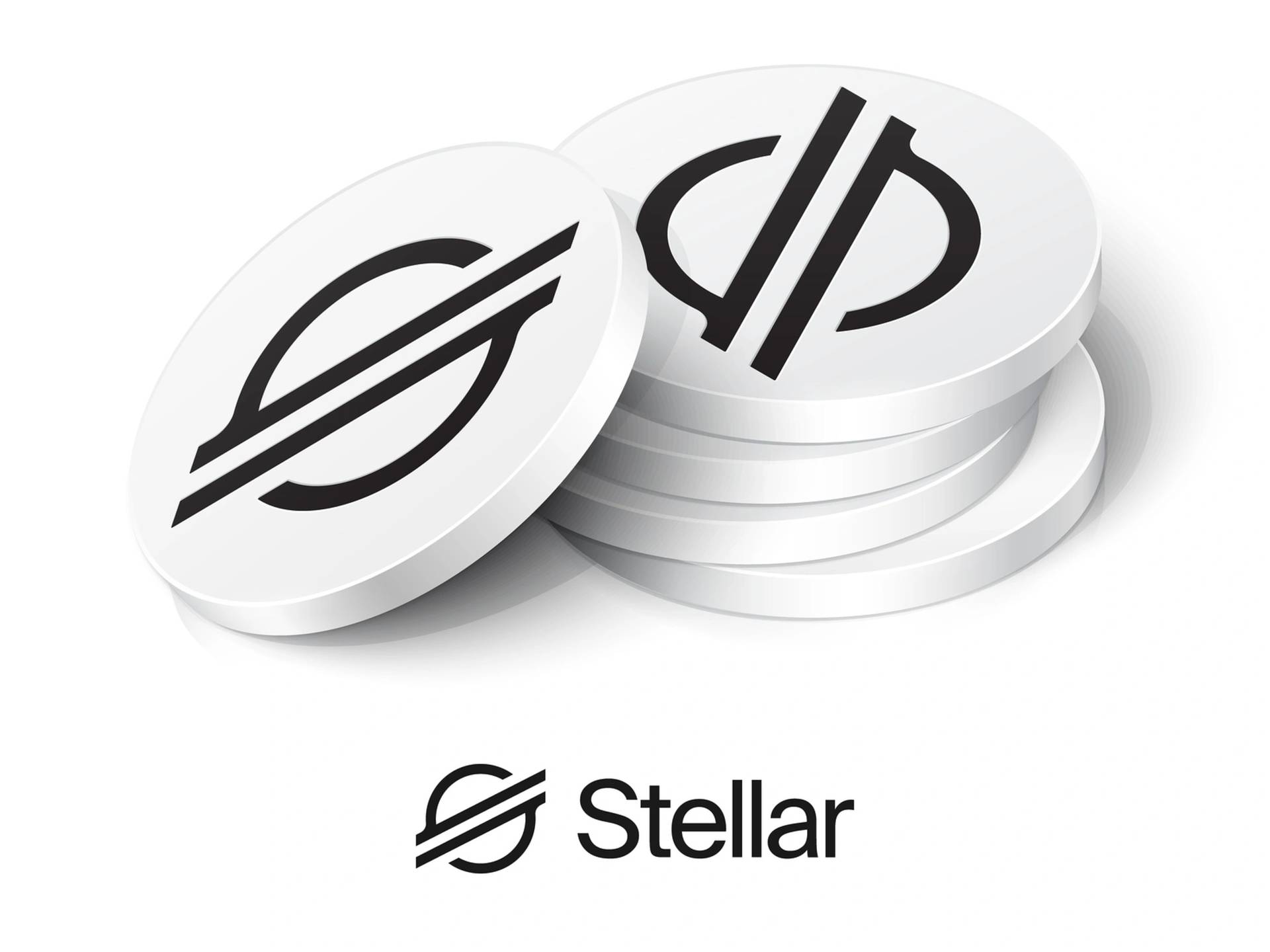Stellar
Stellar Development Foundation (SDF) is a non-profit organization that supports the Stellar network and handles cross-platform transactions and microtransactions. Stellar was originally forked from Ripple’s XRP, however, the code was updated in November 2015 with the Stellar Consensus Protocol (SCP) to decentralize the network.[1][11] Stellar is powered by its own digital currency called Lumens (XLM).[14]
Stellar Network
Stellar Network is a peer-to-peer (P2P) open-source, distributed, and community-owned network created in 2014 by the Stellar Development Foundation (SDF). It is a platform designed to facilitate the transfer of financial resources with minimal costs. It links people, banks, and payment processors, allowing users to create, send, and trade various types of cryptocurrencies. [3][12]
Stellar's mission is to reduce the cost of making payments across borders. The network charges a minimum fee of 0.00001 XLM per transaction. Multiple transactions lead to an increase in fees charged. Stellar gives priority to projects that involve more transactions. If two or more projects have the same fee, they are shuffled and the one on top gets put into the blockchain's ledger. The others wait their turn or get deleted if they have waited too long. [2]
Anchors
Stellar's functionality is powered by a development known as Anchors. Anchors are trusted entities that hold deposits and issue credit. An anchor's function is to issue assets - Bitcoin, USD, and ICO tokens. These assets are exchanged if sufficient credit has been issued by the anchor. [1]
Anchors are utilized to enable transfers of value between the traditional banking system and Stellar and are capable of providing a range of services, including asset issuance, creating on/off ramps, offering access to XLM or USDC on Stellar, and integrating a Stellar Ecosystem Protocol (SEP) to facilitate communication with other projects on the network.
They function similarly to banks or PayPal, holding funds and issuing credit to a wallet. The virtual wallet on the receiving end can receive the credit, which is then converted to any supported fiat currency such as EUR, USD, AUD, etc. [4]

History
Jed McCaleb, [13] one of the founders of Ripple founded Stellar with lawyer Joyce Kim in 2013. Jed McCaleb left Ripple to build Stellar in 2013 following disagreements over the company's future direction. Explaining the rationale behind Stellar, McCaleb told CoinMarketCap:
“The whole original design of Stellar is that you can have fiat currencies and other kinds of forms of value run in parallel with each other and with crypto assets. This is super important to drive this stuff mainstream.” [3]
In 2016, cofounder Joyce Kim resigned from Stellar stating that she would be "passing on the torch" of executive director to her cofounder, Jed McCaleb. [5]
In March 2019, former Mozilla exec. Denelle Dixon joined the Stellar Development Foundation (SDF) as CEO as Jed McCaleb moved on to the role of Chief Architect. [9]
Controversy
In 2015, Stellar entered a legal battle with Ripple, Bitstamp alongside Jed McCaleb over $1,038,172 held by digital currency exchange Bitstamp.
Bitstamp argued in its original complaint that it was unable to determine whether Ripple Labs or defendant Jacob Stephenson, McCaleb's cousin, was the rightful owner of the disputed funds. Stephenson had sold XRP – the native currency of the Ripple network – to Ripple in a sale on Bitstamp, an action that Ripple argued was done on McCaleb's behalf in violation of a settlement agreement. [6] Ripple alleged that McCaleb had violated an agreement governing the sale of his XRP holdings, which numbered 9 billion tokens at the time. Ripple further alleged that McCaleb, in conjunction with members of his family, sought to bypass the agreement in order to sell the XRP beyond its contractual controls. [7]
Additionally, the Stellar Development Fund (SDF) asked to be entered into the suit as an intervenor-defendant. The defense also questioned the basis of Bitstamp’s original complaint for interpleader itself. In Stellar’s 22nd May motion to intervene, the organization echoed past defense filings by stating that Ripple never had claim on the funds in the first place, a statement which it says is backed up by Ripple and Bitstamp’s own filings:
“Bitstamp clearly knew from Ripple’s own statements, as alleged in the complaint, that Ripple did not have a claim that the particular funds contained in the r3Q and rPQ accounts (a total of $1,038,172) belonged to Ripple. Rather, Bitstamp knew that Ripple was asserting only that McCaleb had breached a contract with Ripple, and that Ripple might be entitled to damages in the amount of funds paid by Ripple in the transaction.” [6]
Settlement
In 2016, Ripple settled the $1 million lawsuit with McCaleb in an agreement and released all claims to the dispute XRP. The disputed funds, deposited with the US District Court for the Northern District of California during the trial, were released to Stellar.
As part of the settlement, McCaleb sold his equity in Ripple and agreed to sale controls on 5.3bn XRP owned by him and his children. An additional 2bn XRP was also donated to an undisclosed charitable fund. [7]
Stellar Lumens (XLM)
Lumens (XLM) are the native digital currency of the Stellar network. XLM functions as the intermediate currency for operations and it is also used to pay transaction fees on the network.
100 billion XLM were issued during the network launch in 2014 and for the first 5 years of Stellar’s existence, the supply of lumens increased by 1% annually, by design. The inflation mechanism was terminated by a community vote in October 2019, resulting in a decrease in the total lumen supply in November 2019. [10]
After burning over half of the cryptocurrency’s supply, SDF explained:
“SDF can be leaner and do the work it was created to do using fewer lumens… Those 55.5 billion lumens weren’t going to increase the adoption of Stellar.” [3][8]
Stellar does not support mining of XLM. It adopts a consensus system called Stellar Consensus Protocol (SCP) in which transactions are approved by using a portion of its network. It is built around the proof of stake model. [4]
A minimum of one XLM is required in order to have an active Stellar account.
Utility
Spam Prevention
Lumens are used to cover the cost of transaction fees and to maintain minimum account balances on the Stellar network. This is intended to reduce the number of spam transactions on the network. Each transaction requires a fee of 0.00001 lumens.
Multi-currency Transactions
Lumens facilitate trades between two separate currencies when there is not a large enough direct market.
Decentralization
Stellar's database is open-source, with no single authority controlling the movement of Lumens. Transactions are authorized by the community, with data stored on the blockchain and accessible to all.
Transfer Speed
Transaction time facilitated by the Stellar consensus mechanism is approximately 3-5 seconds. The Stellar Blockchain can support thousands of transactions per second, enabling the use of smart contracts and multi-signatures.
Low Translation Cost
Stellar blockchain has a low translation cost compared to alternative methods. The annual inflation rate is a fixed amount of 1%. [3][1]
The Meridian Conference
The 4th annual Meridian Conference 2022, was an in-person conference that took place from October 11-13, in Rome, Italy. The theme for the conference was THE URGENCY OF DOING inspired by da Vinci’s call to action. The conference featured over 40 sessions including keynotes, panels, fireside chats, debates, networking opportunities, interactive sessions, and more. [21]
The 2023 Meridian Conference is set to take place in Madrid, Spain from September 26 to 28. Actor and UN Goodwill Ambassador Idris Elba will be opening the event. [24]
Soroban
SDF announced in March 2022 its plan to bring Turing-complete smart contracts into Stellar. During the 4th annual Meridian conference, Stellar announced that Soroban, the native smart contracts platform on the Stellar network was now live on Futurenet, an incentivized testing environment for first-wave developers. [17][16]
Tomer Weller, Vice President of Tech Strategy at the Stellar Development Foundation, and the lead developer on Soroban stated:
"We built Soroban because, as developers, we didn't see the kind of smart contracts platform we wanted to work with in the market, we saw the friction on other networks and our response is Soroban, smart contracts that are designed for a batteries-included developer experience, for scale, and for reliable access to financial rails through the Stellar network.
With Soroban live on Futurenet, developers can now begin writing and deploying smart contracts in a testing environment and get rewarded for doing so. [16]
SDF also created a $100M adoption fund dedicated to support developers building on Soroban. [16][17]
Stellar Enterprise Fund
The Stellar Enterprise Fund launched in 2020, is a venture-style fund for growing the open-source Stellar network. Its purpose is to make direct investments across all stages up to Series E or make acquisitions in global fintech or blockchain companies. [18]
In 2022, the Enterprise Fund invested in 5 companies and a total of $23.525 million, including $3.25 million dedicated to accelerators focused on startups building in key markets such as Africa and Latin America. The Matching Fund, the Enterprise Fund’s latest investment track, supports more early-stage companies (pre-Series B) interested in building on Stellar, allocating $1.2 million across three companies – Stax, Stablecorp, and Afriex – in 2022. [19]
Partnerships
MoneyGram Access
In June 2022, the global payments platform, MoneyGram announced its partnership with SDF to launch MoneyGram Access. A global on/off-ramp service for digital wallets to increase the utility of digital assets by creating a bridge between cash and cryptocurrencies. [19]
Stellar Aid Assist
With MoneyGram Access, Stellar Aid Assist was built. It is a tool that enables aid organizations to deliver cash assistance to vulnerable populations. Stellar Aid Assist also allows individuals receiving relief payments from aid organizations or governments to remotely receive digital dollars and hold them securely in a digital wallet on their mobile phone. [20]
In the first half of 2023, Stellar Aid Assist won the “Best Innovation in Digital Currency” award at the Digital Currency Conference, and was recognized as a Project to Watch by CoinDesk. [22]
Stellar x Bitso
On July 19, 2023, Bitso, a Latin American crypto exchange integrated Stellar's Anchor Network to expand the payments corridor between Latin America and the rest of the world. The company said in a statement that it developed a solution in partnership with the Stellar Development Foundation to enable businesses around the world to transact in USDC to Argentina, Colombia, and Mexico, where Bitso has a direct connection to local banking systems. [23]
Other Partnerships
- Binance
- Bitfinex
- Coinbase
- Crypto.com
- Dinaro
- Flutterwave
- Interstellar.Exchange
- MoonPay
- Mobius
- Upbit
- Yellow Card
- Circle
- Coinme
